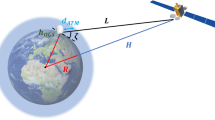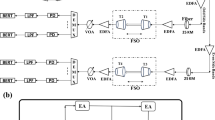Abstract
Free space optical communication (FSO) is growing technology with attractive features like high data rate, no license requirement, high security, and easy installation. But FSO is mainly affected due to the environmental conditions like atmospheric turbulence and many other interferences. Therefore, to improve this disadvantage techniques like spectrum slicing wavelength division multiplexing (SSWDM) were used. SSWDM is used to increase the system performance by providing high capacity and efficiency, it will also help to increase distance of transmission. In this paper, we have compared the performance of FSO with SSWDM and FSO without SSWDM to observe the results for different weather conditions. The results show that spectrum slicing wavelength division multiplexing gives better results for different climatic conditions which improves the system performance.









Similar content being viewed by others
References
Kaushal, H., Kaddoum, G.: Optical communication in space: challenges and mitigation techniques. IEEE Commun. Surv. Tutor. 19, 57–96 (2017)
Kaushal, H., Jain, V.K., Subrat, K.: Free Space Optical Communication. Springer, Berlin (2017)
Prabu, K., Kumar, D.S., Srinivas, T.: Performance analysis of FSO links under strong atmospheric turbulence conditions using various modulation schemes. Optik 125, 5573–5581 (2014)
Sharma, K., Grewal, S.K.: Capacity analysis of free space optical communication system under atmospheric turbulence. Opt. Quant. Electron. 52, 1–18 (2020)
Rashidi, F., Jing, H., Chen, L.: Spectrum slicing WDM for FSO communication systems under the heavy rain weather. Opt. Commun. 387, 296–302 (2017)
Magidi, S., Jabeena, A.: Review on wavelength division multiplexing free space optics. J. Opt. Commun. (2018). https://doi.org/10.1515/joc-2017-0197
Dayal, N., Singh, P., Kaur, P.: Long range cost effective WDM-FSO using hybrid optical amplifiers. Wirel. Pers. Commun. 97, 6055–6067 (2017)
Prabu, K., Charanya, S., Jain, M., Guha, D.: BER analysis of SS-WDM based FSO system for Vellore weather conditions. Opt. Commun. 403, 73–80 (2017). https://doi.org/10.1016/j.optcom.2017.07.012
Singh, H., Mittal, N.: Performance analysis of free space optical communication system under rain weather conditions: a case study for inland and coastal locations of India. Opt. Quant. Electron. 53, 203 (2021)
Thakur, A., Nagpal, S.: Performance evaluation of different optical amplifiers in spectrum sliced free space optical link. J. Opt. Commun. 41, 9–14 (2018)
Thakur, A., Nagpal, S., Gupta, A.: A performance enhancement and high-speed spectrum sliced free space optical system. Wirel. Pers. Commun. 100, 1775–1789 (2018)
Thakur, A., Nagpal, S., Gupta, A.: Kerr effect based spectrum sliced wavelength division multiplexing for free space optical communication. Optik 157, 31–37 (2018). https://doi.org/10.1016/j.ijleo.2017.08.062
Author information
Authors and Affiliations
Corresponding author
Additional information
Publisher's Note
Springer Nature remains neutral with regard to jurisdictional claims in published maps and institutional affiliations.
Rights and permissions
Springer Nature or its licensor holds exclusive rights to this article under a publishing agreement with the author(s) or other rightsholder(s); author self-archiving of the accepted manuscript version of this article is solely governed by the terms of such publishing agreement and applicable law.
About this article
Cite this article
Vasani, E., Shah, V. Investigation of free space optical communication using spectrum slicing under different weather condition. Opt Rev 29, 383–388 (2022). https://doi.org/10.1007/s10043-022-00755-y
Received:
Accepted:
Published:
Issue Date:
DOI: https://doi.org/10.1007/s10043-022-00755-y




